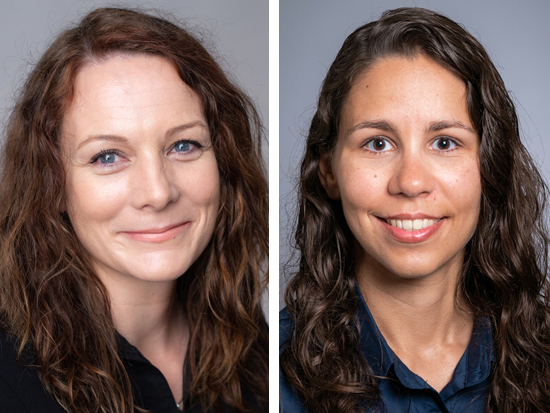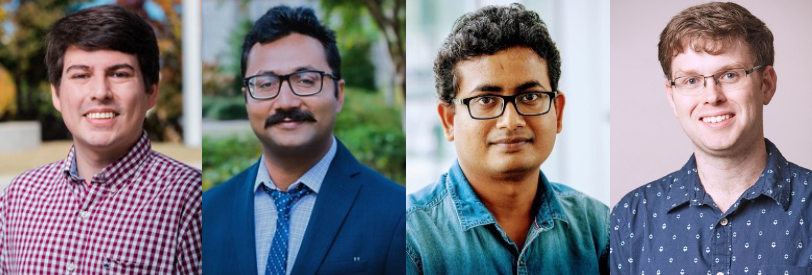 Liz Worthey, Ph.D. (left) and Lara Ianov, Ph.D. (right), director and managing director of the UAB Biological Data Science core.Most core facilities have the mission of making expensive, cutting-edge research equipment available to investigators across UAB’s research enterprise, along with the trained operators to run that equipment.
Liz Worthey, Ph.D. (left) and Lara Ianov, Ph.D. (right), director and managing director of the UAB Biological Data Science core.Most core facilities have the mission of making expensive, cutting-edge research equipment available to investigators across UAB’s research enterprise, along with the trained operators to run that equipment.
The UAB Biological Data Science Core, one of the newest of the 15 Institutional Research Core Facilities at UAB, specializes in something else. The mission of U-BDS is to turn the mass of data generated from these machines, particularly genomic and transcriptomic data, into a form that researchers can work with.
U-BDS was officially opened in 2021, spurred in large part by the explosion in single-cell sequencing technology that began in 2017. The six-person team, led by core director and Associate Professor Liz Worthey, Ph.D., and managing director and Assistant Professor Lara Ianov, Ph.D., provides analysis, develops data pipelines, stays current on the latest methods and algorithms required for cutting-edge research, and even offers web development support.
A major selling point for recruits
“We are not the type of core that is doing the same thing every day,” Ianov said. Recently, a group of departments and centers, working with the Flow Cytometry and Single Cell sequencing core and external grant support, purchased a 10X Xenium, a state-of-the-art single-cell spatial transcriptomics platform. “There have been hundreds of methods that have been published that we need to analyze to determine which ones are most appropriate for our UAB users in that domain,” Ianov said. “It’s not just reading something online; you need to investigate the literature, perform code reviews on the analysis or workflows, and then really ensure it is offering best practices. We will not be the solution for every type of analysis, but we are able to help the majority of users.” As an end result, U-BDS services adhere to best practices established by the team, which include but are not limited to robustness, rigor and reproducibility.
 Other members of the U-BDS team (left to right): Austyn Trull, BSc; Bharat Mishra, Ph.D.; Nilesh Kumar, Ph.D.; and Luke Potter, Ph.D.
Other members of the U-BDS team (left to right): Austyn Trull, BSc; Bharat Mishra, Ph.D.; Nilesh Kumar, Ph.D.; and Luke Potter, Ph.D.
The services of U-BDS are a major selling point for new recruits to UAB, says Jeremy Day, Ph.D., associate professor in the Department of Neurobiology and director of UAB’s Comprehensive Neuroscience Center, who leads the Brain Health Task Force in the Heersink School of Medicine. “You might have the instrument to get the data; but without the person to analyze the data, you are at a standstill,” he said. “Dr. Worthey and Dr. Ianov have been really proactive at building pipelines to turn that data into research findings.”
Researchers say …
 “This was the first time we’d ever used the scRNA seq technique, so having access to the U-BDS core for analysis of this great amount of data was incredibly valuable to our group,” said Carmen De Miguel, Ph.D., M.S., assistant professor in the Division of Nephrology.Earlier this year, the lab of Carmen De Miguel, Ph.D., M.S., assistant professor in the Division of Nephrology, sought the assistance of the U-BDS core for analysis of single-cell RNA sequencing (scRNA seq) data. The data was “from our experiments studying sex differences in kidney immune cells in a mouse model of Type 1 diabetes,” De Miguel said. “This was the first time we’d ever used the scRNA seq technique, so having access to the U-BDS core for analysis of this great amount of data was incredibly valuable to our group.”
“This was the first time we’d ever used the scRNA seq technique, so having access to the U-BDS core for analysis of this great amount of data was incredibly valuable to our group,” said Carmen De Miguel, Ph.D., M.S., assistant professor in the Division of Nephrology.Earlier this year, the lab of Carmen De Miguel, Ph.D., M.S., assistant professor in the Division of Nephrology, sought the assistance of the U-BDS core for analysis of single-cell RNA sequencing (scRNA seq) data. The data was “from our experiments studying sex differences in kidney immune cells in a mouse model of Type 1 diabetes,” De Miguel said. “This was the first time we’d ever used the scRNA seq technique, so having access to the U-BDS core for analysis of this great amount of data was incredibly valuable to our group.”
Many labs, exploring a new area, have a graduate student who becomes the de facto expert. “Eventually, the student will leave and there will be a gap,” Ianov said. “We can help do part of the analysis. Science is complicated; many labs have to focus on study design, molecular prep, protocols and other experiments. It can be overwhelming, and they may not have the skills or the bandwidth. This is where we can help.”
“They were incredibly patient with me, as I was a total newbie in this field,” De Miguel said. “They met with me as often as I needed to understand the outcomes and were very receptive when I had specific requests for ways of plotting the data for the grant that I was drafting at the time.”
Robin Hatton, Ph.D., associate professor in the Department of Pathology, shared about her experience. “While we have the capability in our lab to generate a rather cursory differential gene expression set from bulk RNA-seq data using standard workflows, I was interested in having U-BDS analyze our data because of their emphasis on tailoring analyses to the PI’s specific project,” Hatton said. “Engaging the group was easy and straightforward and while the estimate on job completion time was longer than I would have preferred, I understood my place in the queue. However, the data delivery actually occurred much sooner than the estimated time frame. The U-BDS analysis was comprehensive and thorough, and using a more evolved workflow than our in-house version did indeed reveal transcriptomic differences that ours missed. Needless to say, I was very pleased with the overall interaction and the results.”
Working with U-BDS
As a rule of thumb, “always come to us as early as possible before the actual experiment takes place” by filling out the enquiry form on the U-BDS site, Ianov said. The core provides a free 30-minute consultation to discuss project needs, costs and deadlines. “We have a queue, and we are very upfront when an investigator’s deadline is not feasible,” Ianov said. “We always write up a statement of work beforehand to ensure that everyone understands the deliverables and timelines.”
U-BDS can also “aid investigators whenever they have a grant coming in,” Ianov said. “Let us know and we can meet beforehand and assist with budget justifications and letters of support to show that UAB has a robust system in place.”
That system includes close collaboration with many other UAB research resources, including the university’s high-performance computing cluster, and the Globus data transfer system to securely share massive data output from the data generators to the cluster to hold the data while it is being analyzed.
Training resources
The core now hosts a regular workshop series to train researchers on the techniques they need to do modern genomic and transcriptomic analysis, beginning with programming fundamentals and a two-day course on bulk transcriptomics that it hosted in early July. “If you want to do single-cell and spatial transcriptomics, you need to start with bulk,” Ianov said. “Otherwise, it’s like jumping right into organic chemistry without taking chemistry 101.”
Find more training resources, join the UAB Data Science Slack channel and more at the U-BDS site